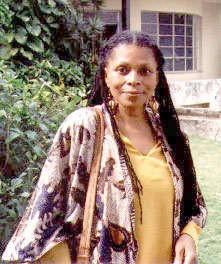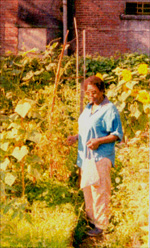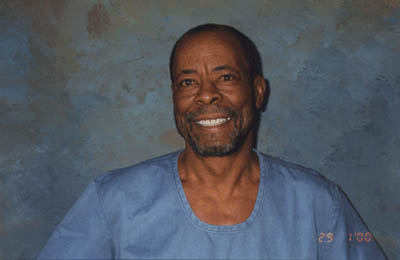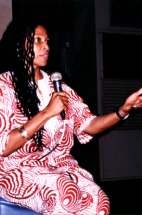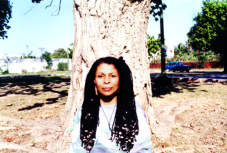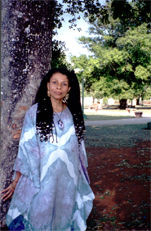ASSATA SHAKUR The Interview
Friday, October 17th, 2008Assata Shakur
What happens to old Black Panthers? Some wind up dead, like Huey P. Newton. Some join the Moonies and the Republican Party, like Eldridge Cleaver. Some, like Mumia Abu Jamal, languish in prison. But a few, like Assata Shakur, have taken the path of the “maroon,” the runaway slave of old who slipped off the plantation to the free jungle communities known as “palenques.” Two decades ago Shakur was described as “the soul of the Black Liberation Army (BLA),” an underground, paramilitary group that emerged from the rubble of east coast chapters of the Black Panther Party. Among her closest political comrades was Afeni Shakur, Tupac Shakur’s mother. Forced underground in 1971, by charges that were later proved false, Assata was accused of being the “bandit queen” of the BLA; the “mother hen who kept them together, kept them moving, kept them shooting.” The BLA’s alleged actions included: assassinating almost ten police officers, kidnapping drug dealers (one of whom turned out to be an FBI agent), and robbing banks from coast to coast. Throughout 1971 and 1972 “Assata sightings” and wild speculation about her deeds were a headline mainstay for New York tabloids. Then, in 1973, Shakur and two friends were pulled over by state troopers on the New Jersey Turnpike. During the stop, shooting erupted. A trooper and one alleged BLA member were killed, another trooper was slightly hurt and Assata-or Miss Joanne Chesimard, as authorities preferred to call her-was severely wounded by a blast of police gunfire. Left to die in a paddy wagon, she survived only to be charged for the trooper’s death and sentenced to life in prison. During the next six years (much of it spent in solitary confinement), Shakur beat a half dozen other indictments. In 1979-after giving birth in prison, only to have her daughter taken away in less than a week Assata Shakur managed one of the most impressive jailbreaks of the era. After almost a year in a West Virginia federal prison for women, surrounded by white supremacists from the Aryan Sisterhood prison gang, Shakur was transferred to the maximum security wing of the Clinton Correctional Center in New Jersey.
There she was one of only eight maximum security prisoners held in a small, well-fenced cellblock of their own. The rest of Clinton-including its visiting area-was medium security and not fenced in. According to news reports at the time, Shakur’s November 2 escape proceeded as follows: Three men-two black, one white-using bogus drivers licenses and Social Security cards, requested visits with Assata four weeks in advance, as was prison policy. But prison officials never did the requisite background checks. On the day of the escape, the team of three met in the waiting room at the prison entrance, where they were processed through registration and shuttled in a van to the visiting room in South Hall. One member of the team went ahead of the rest. Although there was a sign stating that all visitors would be searched with a hand held metal detector-he made it through registration without even a pat-down. Meanwhile, the other two men were processed without a search. As these two were being let through the chain-link fences and locked metal doors at the visiting center one of them drew a gun and took the guard hostage. Simultaneously, the man visiting Shakur rushed the control booth, put two pistols to the glass wall, and ordered the officer to open the room’s metal door. She obliged. From there Shakur and “the raiders” as some press reports dubbed them took a third guard hostage and made it to the parked van. Because only the maximum security section of the prison was fully fenced-in the escape team was able to speed across a grassy meadow to the parking lot of the Hunterdon State School, where they meet two more female accomplices, and split up into a “two-tone blue sedan” and a Ford Maverick. All the guards were released unharmed and the FBI immediately launched a massive hunt. But Shakur disappeared without a trace. For the next five years authorities hunted in vain. Shakur had vanished. Numerous other alleged BLA cadre were busted during those years, including Tupac’s step-father, Mutula Shakur. In 1984 word came from 90 miles off the coast of Florida. The FBI’s most wanted female fugitive was living in Cuba, working on a masters degree in political science, writing her autobiography, and raising her daughter.
Cut to 2001. It’s a stunningly hot summer afternoon in Havana, Cuba the ultimate palenque and I am having strong, black coffee with Assata Shakur who just turned 54, but looks more like 36. She keeps a low profile, security is still a big concern. She’s finishing her second book. Given how much the Fed’s want this woman locked up, I feel strange being in her house, as if my presence is a breach of security.
How did you arrive in Cuba? Well, I couldn’t, you know, just write a letter and say “Dear Fidel, I’d like to come to your country.” So I had to hoof it-come and wait for the Cubans to respond. Luckily, they had some idea who I was, they’d seen some of the briefs and UN petitions from when I was a political prisoner. So they were somewhat familiar with my case and they gave me the status of being a political refugee. That means I am here in exile as a political person. How did you feel when you got here? I was really overwhelmed. Even though I considered myself a socialist, I had these insane, silly notions about Cuba. I mean, I grew up in the 1950s when little kids were hiding under their desks, because “the communists were coming.” So even though I was very supportive of the revolution, I expected everyone to go around in green fatigues looking like Fidel, speaking in a very stereotypical way, “the revolution must continue, Companero. Let us, triumph, Comrade.” When I got here people were just people, doing what they had where I came from. It’s a country with a strong sense of community. Unlike the U.S., folks aren’t as isolated. People are really into other people. Also, I didn’t know there were all these black people here and that there was this whole Afro-Cuban culture. My image of Cuba was Che Guevara and Fidel Castro, I hadn’t heard of Antonio Maceo [a hero of the Cuban war of independence] and other Africans who had played a role in Cuban history. The lack of brand names and consumerism also really hit me. You go into a store and there would be a bag of “rice.” It undermined what I had taken for granted in the absurd zone where people are like, “Hey, I only eat uncle so and so’s brand of rice.”
So, how were you greeted by the Cuban state? They’ve treated me very well. It was different from what I expected, I thought they might be pushy. But they were more interested in what I wanted to do, in my projects. I told them that the most important things were to unite with my daughter and to write a book. They said, “What do you need to do that?” They were also interested in my vision of the struggle of African people in the United States. I was so impressed by that. Because I grew up-so to speak-in the movement dealing with white leftists who were very bossy and wanted to tell us what to do and thought they knew everything. The Cuban attitude was one of solidarity with respect. It was a profound lesson in cooperation.
Did they introduce you to people or guide you around for a while? They gave me a dictionary, an apartment, took me to some historical places, and then I was pretty much on my own. My daughter came down, after prolonged harassment and being denied a passport, and she became my number one priority. We discovered Cuban schools together, we did the sixth grade together, explored parks, and the beach. She was taken from you at birth, right? Yeah. It’s not like Cuba where you get to breast feed in prison and where they work closely with the family. Some mothers in the U.S. never get to see their newborns. I was with my daughter for a week before they sent me back to the prison. That was one of the most difficult periods of my life, that separation. It’s only been recently that I’ve been able to talk about it. I had to just block it out, otherwise I think I might have gone insane. In 1979, when I escaped, she was only five years old.
You came to Cuba how soon after? Five years later, in 1984. I know it’s probably out of bounds, but where were you during the intervening years? I was underground. But I don’t talk about that period. To do so would put a lot of people who helped me in jeopardy. Right, I hear you. You’ve talked about adjusting to Cuba, but could you talk a bit about adjusting to exile. Well, for me exile means separation from people I love. I didn’t, and don’t miss the U.S., per se. But black culture, black life in the U.S., that African American flavor, I definitely miss. The language, the movements, the style, I get nostalgic about that. Adjusting to exile is coming to grips with the fact that you may never go back to where you come from. The way I dealt with that, psychologically, was thinking about slavery. You know, a slave had to come to grips with the fact that “I may never see Africa again.” Then a maroon, a runaway slave, has to-even in the act of freedom-adjust to the fact that being free or struggling for freedom means, “I’ll be separated from people I love.” So I drew on that and people like Harriet Tubman and all those people who got away from slavery. Because, that’s what prison looked like. It looked like slavery. It felt like slavery. It was black people and people of color in chains. And the way I got there was slavery. If you stand up and say, “I don’t go for the status quo.” Then “we got something for you, it’s a whip, a chain, a cell.” Even in being free it was like, “I am free but now what?” There was a lot to get used to. Living in a society committed to social justice, a third world country with a lot of problems. It took a while to understand all that Cubans are up against and fully appreciate all they are trying to do.
Did the Africanness of Cuba help, did that provide solace? The first thing that was comforting was the politics. It was such a relief. You know, in the States you feel overwhelmed by the negative messages that you get and you just feel weird, like you’re the only one seeing all this pain and inequality. People are saying, “Forget about that, just try to get rich, @#%$ eat @#%$, get your own, buy, spend, consume.” So living here was an affirmation of myself, it was like “Okay, there are lots of people who get outraged at injustice.” The African culture I discovered later. At first I was learning the politics, about socialism-what it feels like to live in a country where everything is owned by the people, where health care and medicine are free. Then I started to learn about the Afro-Cuban religions, the Santaria, Palo Monte, the Abakua. I wanted to understand the ceremonies and the philosophy. I really came to grips with how much we-Black people in the U.S.-were robbed of. Whether it’s the tambours, the drums, or the dances. Here, they still know rituals preserved from slavery times. It was like finding another piece of myself. I had to find an African name. I’m still looking for pieces of that Africa I was torn from. I’ve found it here in all aspects of the culture. There is a tendency to reduce the Africanness of Cuba to the Santaria. But it’s in the literature, the language, the politics.
When the USSR collapsed, did you worry about a counter revolution in Cuba and, by extension, your own safety? Of course. I would have to have been nuts not to worry. People would come down here from the States and say, “How long do you think the revolution has-two months, three months? Do you think the revolution will survive? You better get out of here.” It was rough. Cubans were complaining every day, which is totally sane. I mean, who wouldn’t? The food situation was really bad, much worse than now, no transportation, eight-hour blackouts. We would sit in the dark and wonder, “How much can people take?” I’ve been to prison and lived in the States, so I can take damn near anything. I felt I could survive whatever-anything except U.S. imperialism coming in and taking control. That’s the one thing I couldn’t survive. Luckily, a lot of Cubans felt the same way. It took a lot for people to pull through, waiting hours for the bus before work. It wasn’t easy. But this isn’t a superficial, imposed revolution. This is one of those gut revolutions. One of those blood, sweat and tears revolutions. This is one of those revolutions where people are like, “We ain’t going back on the plantation, period. We don’t care if you’re Uncle Sam, we don’t care about your guided missiles, about your filthy, dirty CIA maneuvers. We’re this island of 11 million people and we’re gonna live the way we want and if you don’t like it, go take a ride.” And we could get stronger with the language. Of course, not everyone feels like that, but enough do.
What about race and racism in Cuba? That’s a big question. The revolution has only been around 30-something years. It would be fantasy to believe that the Cubans could have completely gotten rid of racism in that short a time. Socialism is not a magic wand: wave it and everything changes. Can you be more specific about the successes and failures along these lines? I can’t think of any area of the country that is segregated. Another example, the third congress of the Cuban Communist Party was focused on making party leadership reflect the actual number of people of color and women in the country. Unfortunately by the time the Fourth Congress rolled around the whole focus had to be on the survival of the revolution. When the Soviet Union and the socialist camp collapsed Cuba lost something like 85 percent of its income. It’s a process but I honestly think that there’s room for a lot of changes throughout the culture. Some people still talk about “good hair” and “bad hair.” Some people think light skin is good, that if you marry a light person you’re advancing the race. There are a lot of contradictions in peoples’ consciousness. There still needs to be de-eurocentrizing of the schools, though Cuba is further along with that than most places in the world. In fairness, I think that race relations in Cuba are 20 times better than they are in the States and I believe the revolution is committed to eliminating racism completely. I also feel that the special period has changed conditions in Cuba. It’s brought in lots of white tourists, many of whom are racists and expect to be waited on subserviently. Another thing is the joint venture corporations which bring their racist ideas and racist corporate practices, for example not hiring enough blacks. All of that means the revolution has to be more vigilant than ever in identifying and dealing with racism. A charge one hears, even on the left, is that institutional racism still exists in Cuba. Is that true? Does one find racist patterns in allocation of housing, work, or the functions of criminal justice? No. I don’t think institutional racism, as such, exists in Cuba. But at the same time, people have their personal prejudices. Obviously these people, with these personal prejudices, must work somewhere, and must have some influence on the institutions they work in. But I think it’s superficial to say racism is institutionalized in Cuba. I believe that there needs to be a constant campaign to educate people, sensitize people, and analyze racism. The fight against racism always has two levels; the level of politics and policy but also the level of individual consciousness. One of the things that influences ideas about race in Cuba is that the revolution happened in 1959, when the world had a very limited understanding of what racism was. During the 1960s, the world saw the black power movement, which I, for one, very much benefited from. You know “black is beautiful,” exploring African art, literature, and culture. That process didn’t really happen in Cuba. Over the years, the revolution accomplished so much that most people thought that meant the end of racism. For example, I’d say that more than 90 percent of black people with college degrees were able to do so because of the revolution. They were in a different historical place. The emphasis, for very good reasons, was on black-white unity and the survival of the revolution. So it’s only now that people in the universities are looking into the politics of identity. What do you think of the various situations of your former comrades? For example, the recent releases of Geronimo Pratt, Johnny Spain, and Dhoruba Bin Wahad; the continued work of Angela Davis and Bobby Seale and, on a downside, the political trajectory of Eldridge Cleaver and the death of Huey Newton? There have been some victories. And those victories have come about from a lot of hard work. But it took a long time. It took Geronimo 27 years and Dhoruba 19 years to prove that they were innocent and victimized by COINTELPRO. The government has admitted that it operated COINTELPRO but it hasn’t admitted to victimizing anyone. How can that be? I think that people in the States should be struggling for the immediate freedom of Mumia Abu Jamal and amnesty for all political prisoners. I think that the reason these tasks are largely neglected reflects not only the weakness of the left, but its racism. On the positive side, I think a lot of people are growing and healing. Many of us are for the first time analyzing the way we were wounded. Not just as Africans, but as people in the movement who were, and still are, subjected to terror and surveillance. We’re finally able to come together and acknowledge that the repression was real and say, “We need to heal.” I have hope for a lot of those people who were burnt out or addicted to drugs or alcohol, the casualties of our struggle. Given all that we were and are up against I think we did pretty well.
What effect do you think Rap music has on the movement for social justice
today?
Hip Hop can be a very powerful weapon to help expand young people’s political and social consciousness. But just as with any weapon, if you don’t know how to use it, if you don’t know where to point it, or what you’re using it for, you can end up shooting yourself in the foot or killing your sisters or brothers. The government recognized immediately that Rap music has enormous revolutionary potential. Certain politicians got on the bandwagon to attack Rappers like Sister Soldier and NWA. You’ve got various police organizations across the country who have openly expressed their hostility towards Rap artists. For them, most Rappers fall in the category of potential criminals, cop killers, or subversives. If you don’t believe that the FBI has extensive files on every popular Rap artist, you probably believe in the Easter bunny or the tooth fairy. It’s a known fact that more than a few Rappers are under constant police surveillance. There’s been speculation that Tupac Shakur was set up on those rape charges. He makes reference to it in one of his songs.
Do you think there is a COINTELPRO program against Rappers? It’s a definite possibility. Divide and conquer is what the FBI does best. Just look at the history. The FBI engineered the split in the Black Panther party. The police and the government have pitted organizations against each other, gangs against each other, leaders against each other. Now you’ve got this East coast versus West coast thing.
Look, we came over on the same boats, we slaved on the same plantations together, and we’re all being oppressed, brutalized, and incarcerated together in mega numbers, what sense does it make for us to be fighting each other? So yes, I believe the government encouraged this in-fighting, and I wouldn’t be surprised to find out that they set Tupac up more than once. What did you think of Tupac’s music? I think Tupac was a genius. He had so much talent. I love his music, even when I don’t agree with what he’s saying or the premises he’s operating on. He was able to touch so much gut stuff, that most people don’t even recognize, much less have the ability to express.
i believe in living.
i believe in living.
i believe in the spectrum
of Beta days and Gamma people.
i believe in sunshine.
In windmills and waterfalls,
tricycles and rocking chairs;
And i believe that seeds grow into sprouts.
And sprouts grow into trees.
i believe in the magic of the hands.
And in the wisdom of the eyes.
i believe in rain and tears.
And in the blood of infinity.
i believe in life.
And i have seen the death parade
march through the torso of the earth,
sculpting mud bodies in its path
i have seen the destruction of the daylight
and seen bloodthirsty maggots
prayed to and saluted
i have seen the kind become the blind
and the blind become the bind
in one easy lesson.
i have walked on cut grass.
i have eaten crow and blunder bread
and breathed the stench of indifference
i have been locked by the lawless.
Handcuffed by the haters.
Gagged by the greedy.
And, if i know anything at all,
it’s that a wall is just a wall
and nothing more at all.
It can be broken down.
i believe in living
i believe in birth.
i believe in the sweat of love
and in the fire of truth.
And i believe that a lost ship,
steered by tired, seasick sailors,
can still be guided home to port.
-Assata Shakur
